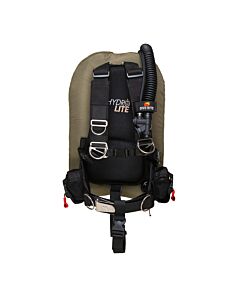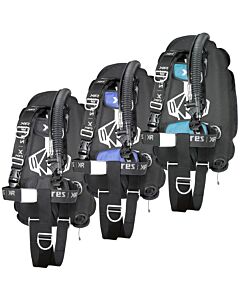Travel BC Systems
These are BC systems are a good option to minimize volume and weight for travel while offering the benefits of back inflation BCD.
-
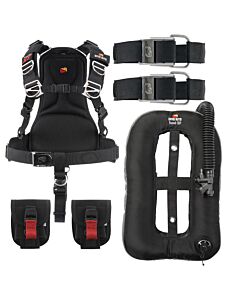 DGX Custom - Dive Rite TransPac Singles BC PackageAs Low As $849
DGX Custom - Dive Rite TransPac Singles BC PackageAs Low As $849 -
 Dive Rite Hydro Lite BC - Blue$629.00
Dive Rite Hydro Lite BC - Blue$629.00 -
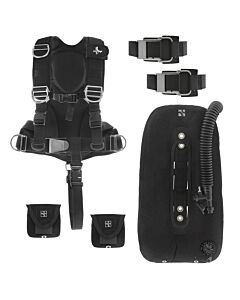 DGX Gears SoftPack BCD Package$489.00
DGX Gears SoftPack BCD Package$489.00 -
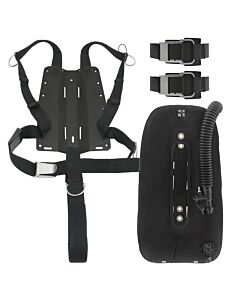 DGX Custom - DGX Gears Singles Harness / Backplate / Wing PackageAs low as $449.00
DGX Custom - DGX Gears Singles Harness / Backplate / Wing PackageAs low as $449.00
Bad BCD Maintenance = Provoking Instead of Preventing
Most buoyancy control devices (BCD) have no specific periodic maintenance interval recommendations, all though a few manufacturers suggest an "inspection" when the regulator is serviced. Periodically we hear from divers who have damaged their wings by improper BCD 'over-maintenance'. The most common damage takes the form of loss of the sealing gasket in the inflation assembly or OPV. Another common damage is cross threading of the fittings on the inflation assembly or OPV; it's very easy to do because the threads are very fine and materials relatively soft. Both of these problems occur when the diver has made a routine practice of disassembling the inflation assembly and/or the OPV. Improper maintenance of your BCD can cause a loss of buoyancy control and create a life threatening situation. Dive Gear Express recommends you do not disassemble your BCD as routine maintenance for this very reason. Maintenance of your BCD is easy, no disassembly required.
Before your dive trip, fully inflate your BCD until the OPV releases, let it sit for 15 minutes and then check to see it is still fully inflated; if not, it's leaking. The cause of a leak might be a pinch or puncture, could be damage as described above, but it also may just be a dirty salt encrusted OPV that can be rinsed with fresh water. It's also good practice to occasionally hook up your power inflator, pressurize the regulator, deflate the bladder and let the BCD sit for a while (longer the better.) Then see if the BCD has 'self-inflated', if so the power inflator is dribbling gas and should be replaced.
A test that will often provoke unnecessary maintenance is to fully inflate the BCD and allow it to sit for an extended period such as overnight. Upon inspection many hours later, the bladder is found somewhat deflated and incorrectly assumed to have a leak that needs repair. There are several benign reasons for slight leaks, but the cause is usually the fact that the spring loaded OPV sealing surfaces are not perfectly clean or in a new BCD that the bladder flange sealing gasket has settled slightly following initial assembly. You can clean the OPV or take an additional turn on the nut of the inflation assembly elbow (but NOT the entire assembly itself.) There is no need; very slight leaks are acceptable and for a BCD to not be fully inflated after sitting for many hours is commonplace. In most cases, very slight leaks will stop on their own once the BCD is wet; if the slight leak is noticeable underwater then you can take appropriate action.
After diving, hold your BCD upside down with the inflator at the lowest point and depress the oral inflate button to drain the bladder then rinse everything on the outside with a gentle spray of fresh water. Pay close attention to rinsing the 'shiny bits' and especially the power inflator quick-disconnect post. Next, while holding down the oral inflate button, use a hose to add a couple of cups of fresh water to the bladder via the oral inflate mouthpiece, swish the water around inside the bladder, invert the BCD and depress the oral inflator to again drain the water back out. Finally, add water and drain again, but this time drain it out the pull dump if your BCD has a separate combination pull dump & OPV. Then put a small puff of air in the bladder and hang it up in a ventilated area until your next dive trip. Take care not to store your BCD in an enclosed space where moisture can cause corrosion or mildew. Also be careful not to store your BCD near sources of ozone production such as electric motors or electronic devices; the ozone can cause rapid deterioration of the bladder material.
We've seen people use all sorts of stuff to 'clean' or 'sanitize' the inside of BCD bladders, and even using garden hose adapters to 'power wash' the bladder through the inflator QD post, but we think it's a poor practice. There are cleaners specifically for cleaning BCD bladders but nearly all BCD bladder materials already contain antimicrobial agents incorporated directly into the material, so no special cleaners are required. Ordinary tap water works just fine to rinse out your BCD. Just say NO to cleaning your BCD with stuff like dilute sodium hypochlorite (aka 'liquid bleach'), alcohol-containing mouthwash (Listerine®), povidone iodine (Betadine®), or chlorhexidine (Hibiclens®). Bleach is effective but too harsh and the unavoidable splashes will damage the fabric shell. The rest of this stuff is proven ineffective in this type of application and worse many of them will actually damage the internal bladder by reacting chemically with the plastic elasticizer causing the bladder to become brittle.
